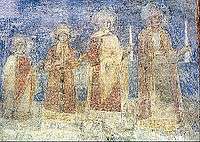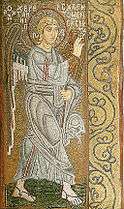Saint Sophia's Cathedral, Kiev
| Saint Sophia's Cathedral, Kiev (Собор святої Софії) | |
| Eastern Orthodox Cathedral | |
 | |
| Name origin: Hagia Sophia | |
| Country | Ukraine |
|---|---|
| Capital city | Kiev |
| Districts | Shevchenko Raion, National Sanctuary "Sophia of Kiev", Holy Sophia Cathedral Complex |
| Municipality | Kiev City |
| Landmarks of complex | Holy Sophia Cathedral, Belltower, Refectory Church, Consistory, House of Metropolitan, Southern entrance tower |
| Coordinates | UA 50°27′10″N 30°30′52″E / 50.45278°N 30.51444°ECoordinates: UA 50°27′10″N 30°30′52″E / 50.45278°N 30.51444°E |
| Length of cathedral | 29.5 m (97 ft) |
| - Length w/galleries | 41.7 m (137 ft) |
| Width of cathedral | 29.3 m (96 ft) |
| - Width w/galleries | 54.6 m (179 ft) |
| Height of main dome | 28.6 m (94 ft) |
| Styles | Byzantine architecture, Ukrainian Baroque |
| Founded | Eastern Orthodox Cathedral |
| - established 1 | Greek-Catholic Cathedral |
| - established 2 | Returned to Orthodox Church |
| Date | 11th century |
| - date 1 | 1596 |
| - date 2 | 1630s |
| Government | Ministry of Culture of Ukraine |
| Leader | Olena Serdiuk |
| UNESCO World Heritage Site | |
| Name | Kiev: Holy Sophia Cathedral and Related Monastic Buildings, Kiev Pechersk Lavra |
| Year | 1990 (#14) |
| Number | 527 |
| Region | Europe and North America |
| Criteria | i, ii, iii, iv |
| Recognition | Seven Wonders of Ukraine[1] |
| Website: http://sophia.sophiakievska.org | |
Saint Sophia Cathedral in Kiev is an outstanding architectural monument of Kievan Rus'. The cathedral is one of the city's best known landmarks and the first heritage site in Ukraine to be inscribed on the World Heritage List along with the Kiev Cave Monastery complex.[2][nb 1] Aside from its main building, the cathedral includes an ensemble of supporting structures such as a bell tower and the House of Metropolitan. In 2011 the historic site was reassigned from the jurisdiction of the Ministry of Regional Development of Ukraine to the Ministry of Culture of Ukraine.[4][5] One of the reasons for the move was the fact that both "Sofia Kyivska" and Kiev Pechersk Lavra are recognized by the UNESCO World Heritage Program as one complex, while in Ukraine the two were governed by different government entities.
In Ukrainian the cathedral is known as Sobor Sviatoyi Sofiyi (Собор Святої Софії) or Sofiyskyi sobor (Софійський собор). In Russian it is known as Sobor Svyatoi Sofii (Собор Святой Софии) or Sofiyskiy sobor (Софийский собор).
The complex of the Cathedral is the main component and museum of the National Preserve "Sophia of Kiev" which is the state institution responsible for the preservation of the Cathedral complex as well as four other historic landmarks across the nation.
History
The cathedral's name comes from the 6th-century Hagia Sophia cathedral in Constantinople (meaning Holy Wisdom, and dedicated to the Holy Wisdom rather than a specific saint named Sophia). Architecture-wise, its model could have been the 13-domed oaken Holy Sophia Cathedral in Novgorod (c. 989), which Yaroslav I the Wise determined to imitate in stone as a sign of gratitude to the citizens of Novgorod who had helped him secure the Kievan throne in 1019.
The first foundations were laid in 1037 or 1011,[6] but the cathedral took two decades to complete. According to Dr. Nadia Nikitenko, an historian who has studied the cathedral for 30 years, the cathedral was founded in 1011, under the reign of Yaroslav's father, Grand Prince of Kievan Rus', Vladimir the Great. This info has been accepted by both UNESCO and Ukraine, which officially celebrated the 1000th anniversary of the cathedral during 2011.[7]) The structure has 5 naves, 5 apses, and (quite surprisingly for Byzantine architecture) 13 cupolas. It is surrounded by two-tier galleries from three sides. Measuring 37 to 55 m (121 to 180 ft), the exterior used to be faced with plinths. On the inside, it retains mosaics and frescos from the 11th century, including a dilapidated representation of Yaroslav's family, and the Orans.
Originally the cathedral was a burial place of the Kievan rulers including Vladimir Monomakh, Vsevolod Yaroslavich and the cathedral's founder Yaroslav I the Wise, although only the latter's grave survived to this day (see picture).
After the pillaging of Kiev by Andrei Bogolyubsky of Vladimir-Suzdal in 1169, followed by Mongolian Tatars in 1240, the cathedral fell into disrepair. It was also greatly damaged in the 16th century, when Poland and Ukraine were trying to unite catholic and orthodox churches. At this period the Cathedral was almost ruined: its roof decayed and a lot of wall paintings had gone. Following the 1595-96 Union of Brest, the Cathedral of Holy Sophia belonged to the Ukrainian Greek Catholic Church until it was claimed by the Moldavian Orthodox metropolitan Peter Mogila (Mohyla) in 1633. Mogila commissioned the repair work and the upper part of the building was thoroughly rebuilt, modeled by the Italian architect Octaviano Mancini in the distinct Ukrainian Baroque style, while preserving the Byzantine interior, keeping its splendor intact. The work continued under the Cossack Hetman Ivan Mazepa until 1767. During this period around Holy Sophia Cathedral a bell tower, a monastery canteen, a bakery, a "House of Metropolitan", the western gates (Zborovsky gates), a Monastic Inn, a Brotherhood campus and a bursa (seminary) were all erected. All of these buildings as well as the Cathedral after the reconstruction have distinctive features of Ukrainian Baroque.
After the Russian Revolution of 1917 and during the Soviet anti-religious campaign of the 1920s, the government plan called for the cathedral's destruction and transformation of the grounds into a park "Heroes of Perekop" (after a Red Army victory in the Russian Civil War in Crimea). The cathedral was saved from destruction[8] (the opposite St. Michael's Golden-Domed Monastery was destroyed in 1935[8]) primarily with the effort of many scientists and historians. Nevertheless, in 1934, Soviet authorities confiscated the structure from the church, including the surrounding 17th–18th century architectural complex and designated it as an architectural and historical museum.
Since the late 1980s Soviet, and later Ukrainian, politicians promised to return the building to the Orthodox Church. Due to various schisms and factions within the Church the return was postponed as all Orthodox and the Greek-Catholic Churches lay claim to it. Although all of the Orthodox churches have been allowed to conduct services at different dates, at other times they are denied access. A severe incident was the funeral of Patriarch Volodymyr of the Ukrainian Orthodox Church - Kiev Patriarchy in 1995, when riot police were forced to prevent the burial on the premises of the museum and a bloody clash took place. After events such as those no religious body has yet been given the rights for regular services. The complex now remains a secular museum of Ukraine's Christianity, with most of its visitors being tourists.
On 21 August 2007, the Holy Sophia Cathedral was named one of the Seven Wonders of Ukraine, based on votes by experts and the internet community.
|
Cathedral complex


- Sophia Cathedral
- Bell tower
- House of the Metropolitan
- Refectory Church
- Brotherhood building
- Bursa (high school)
- Consistory
- Southern entrance tower
- Zaborovsky Gate
- Cells
- Monastic Inn
- Memorial Stela of Yaroslav's library
Burials
- People buried at Sophia
See also
- Architecture of Kievan Rus'
- List of UNESCO World Heritage Sites in Ukraine
- Holy Sophia Cathedral in Novgorod
- Saint Sophia Cathedral in Polotsk
Notes
- ↑ In late 2010 a UNESCO monitoring mission was visiting the Kiev Pechersk Lavra to check the situation of the site. At the time the Minister of Culture Mykhailo Kulynyak stated the historic site along with the Holy Sophia Cathedral was not threatened by the "black list" of the organization.[3] The World Heritage Committee of UNESCO decided in June 2013 that Kiev Pechersk Lavra, and St Sophia's Cathedral along with its related monastery buildings would remain on the World Heritage List.[2]
References
- ↑ "7 чудес України - Новини". Retrieved 10 July 2015.
- 1 2 Kyiv Pechersk Lavra, St. Sophia Cathedral remain on UNESCO’s World Heritage List, Interfax-Ukraine (20 June 2013)
- ↑ "Міністерство культури України". Retrieved 10 July 2015.
- ↑ "Міністерство культури України". Retrieved 10 July 2015.
- ↑ Голос України.–2011.–9 лютого. Міністерств багато, а Софія Київська – одна.–Градоблянська Т. (government website)
- ↑ Facts.kieve.ua
- ↑ Booklet "The Millenary of St. Sophia of Kyiv" by Nadia Nikitenko, Kyiv 2011
- 1 2 Forgotten Soviet Plans For Kyiv, Kyiv Post (28 July 2011)
External links
| Wikimedia Commons has media related to Saint Sophia Cathedral in Kiev. |
- 3D-model of Sophia Cathedral (3.2 Mb)
- (Ukrainian) Official Website of the museum
- Holy Sophia Cathedral - Kiev History Site
- (Russian) Sobory.ru - information about the cathedral
- Travel.kyiv.org - information for tourists
- Mosaics and frescoes of St. Sophia Cathedral
- (Ukrainian) Софійський собор in Wiki-Encyclopedia Kyiv
- (English) Must see places in Kiev - Holy Sophia Cathedral
- Mosaics and Frescoes of St. Sophia`s Cathedral of Kyiv. Photoalbum. Kyiv, Mistectvo, 1975.

_-_Google_Art_Project.jpg)






